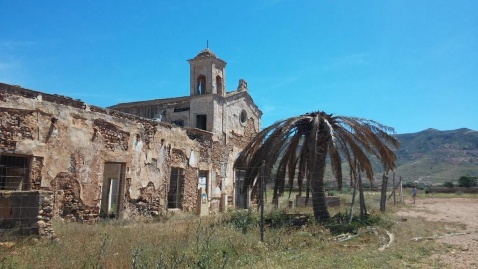
Cortijo del Fraile in 2015 © Alicia Cerezuela @alacia_cere |
|

Cortijo del Fraile in 2015 © Alicia Cerezuela @alacia_cere |
|
Cortijo del Fraile
Cortijo del Fraile (Farmhouse of the Friar) is a isolated ruined farmhouse in the Campos de Nijar near a small village called Los Albaricoques, belonging to a private agricultural estate. Local administration and residents have tried, unsuccessfully, to persuade the owner of the 730 ha estate to restore the cortijo, or at least protect it from further natural destruction.
The cortijo is an enclosure of buildings surrounded by a low white wall, typical of Andalucian estates, with a central patio, chapel with bell tower and crypt, outside ovens, and a well.
It was built by Dominican Brothers from Almería in the 18th century, hence the name, and was also known as the Cortijo del Hornillo (Farmhouse of the Little Oven) as there was a bread oven in the central patio. In 1836, it was confiscated by the state (as part of a national expropriation of church properties) and following an auction sold to private family.
The historic cortijo was declared a BIC de Andalucia (Bien de Interes Cultural, object of cultural interest) in 2010. More walls collapsed in 2011, leading to discussions with the Junta de Andalucia to buy the cortijo.
>Why so much interest in the cortijo?
An imposing building in a remote location, it has been used as a set for a number of films over the years, including the Clint Eastwood western classics The Good, the Bad and the Ugly and For a Few Dollars More, as well as some Italian westerns and a couple of Spanish TV dramas.
See the cortijo in the Clint Eastwood film The Good, the Bad and the Ugly in the video below. Tuco (The Ugly, Eli Wallach) drives a six horse-drawn coach (like a stagecoach) which stops in front of the Cortijo, a Catholic mission run by his brother. A monk comes out of the building, and he and Tuco together take the injured Blondie (The Good, Clint Eastwood) inside.
Blood Wedding
On a more macabre note, on 22 July 1928 the "Crimen de Nijar" (Crime of Nijar) took place at the cortijo, which inspired Federico Garcia Lorca to write his famous play Blood Wedding, and Carmen de Burgos to pen the novel Puñal de Claveles.
Francisca Cañadas Morales was born in Nijar in 1908 and lived in Cortijo los Frailes. She was known as Paquita La Coja (Paquita the Lame) because of her gammy leg. Some attribute this to polio, others to a hip dislocation when her father smacked her bottom too hard as a baby to stop her crying. Her father arranged for her to marry Casimiro Perez Pino, who lived near the cortijo.
The wedding party met at the Cortijo del Fraile in the evening for the nighttime wedding (traditional in those days) and guests noticed the bride was missing. Then they realised that her cousin Francisco Montes Cañadas was also missing and they worked out that she had eloped with the man she had been close to from a young age. The guest began searching and found Paquita a mile away, with her clothes torn and a bloody neck, claiming to have been strangled by masked robbers.
Francisco's body was found 8km away at Cañada Honda Serrata (later marked by an impromptu cairn of small stones and a wooden cross) on the track to Los Pipaces, shot three times. José Pérez, the brother of the abandoned groom, handed himself in. He claimed at the trial that he had not pulled the trigger, but would not say who did. Perez was found guilty and given a seven year prison term, but only served three, and died shortly after of typhus. Francisca's attempted murderers were Carmen Glen, her own sister and wife of José Perez. The killers were hooded and Francisca claimed to recognize the voices but refused to reveal the identities. Carmen was found guilty of attempted murder and served a 15-month jail sentence.
The groom Casimiro was found to be innocent of any connection with the murder. He never spoke to Francisca again and later married Josefa Segura. They lived in the fishing village of San José with their two children and he died in 1990. Francisca lived quietly as a recluse at El Hualix near the Cortijo, cared for by a niece. She never married, and refused to tell her story, despite petitions from journalist all over the world. She only met Carmen once again - when Francesca was very ill, Carmen came to the bedside and apologized. Francisca forgave her, but did not want to talk. Francisca died in 1987 and was buried in Nijar cemetery, not far from her murdered cousin.
What can you see today?
The abandoned and delapidated cortijo is surrounded by a fence which you can see through, but sadly is not open to the public currently, so that view is the closest you can get. The area is remote, with few other houses nearby.
After years of pressure by citizens groups including a Facebook group "Save Cortijo de Fraile" in June 2021 the Diputacion de Almeria announced that an agreement with the owners had been reached and the Diputacion would buy Cortijo de Fraile and 23 surrounding hectáreas for its rehabilitation to be used as a 'cultural epicentre' of the Levante (eastern area) and the Parque Natural Cabo de Gata-Níjar.
How to get there
Cortijo del Fraile is located about 7km off the main road and reasonably easy to find. It can be visited by car, no need for a 4x4. GPS: 36.865612, -2.074930
From Fernán Perez. Take the road towards Los Albaricoques, and after 2km look for a sign pointing to a dirt track on the left hand side. Take this track for 7km (4x4 not needed).
From Los Albaricoques: Take the ALP-824 road, which soon becomes a rough track towards Rodalquilar. It is signposted Cortijo del Fraile and Rodalquilar.